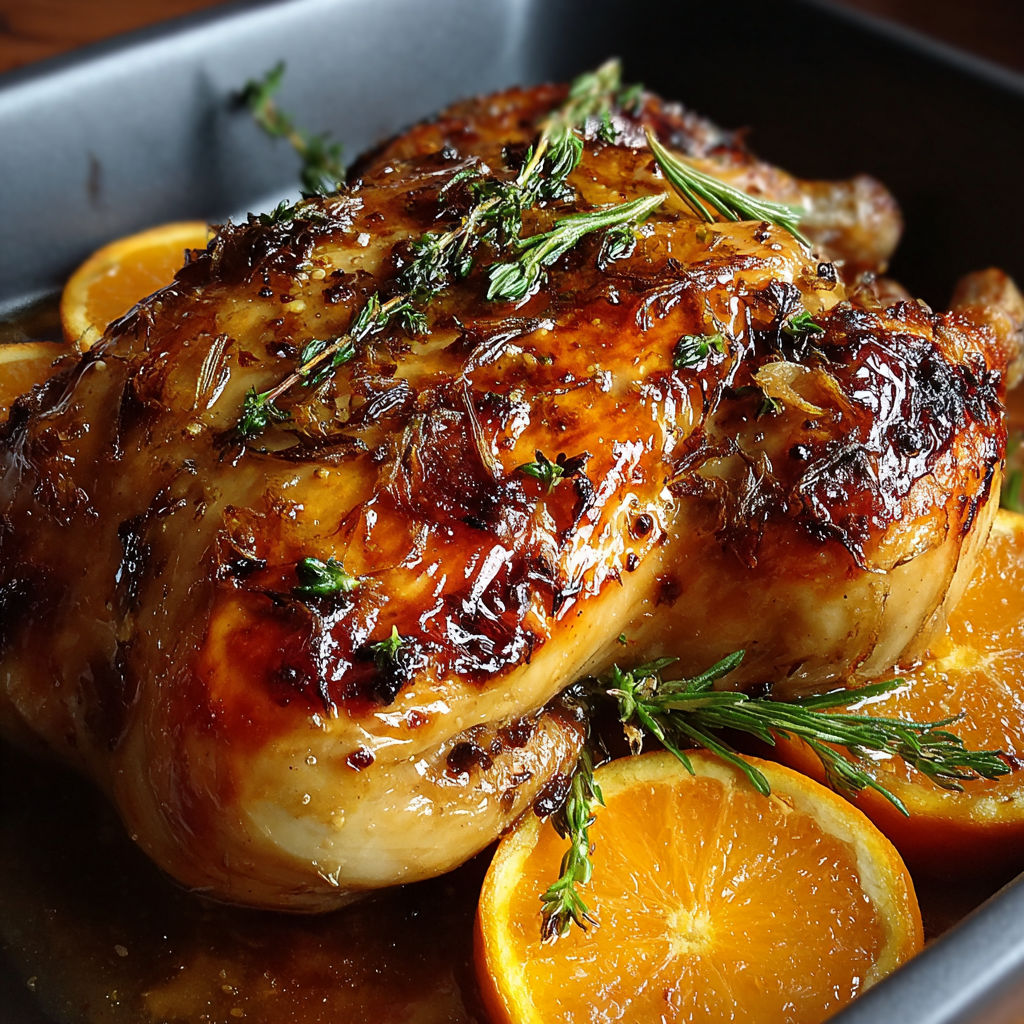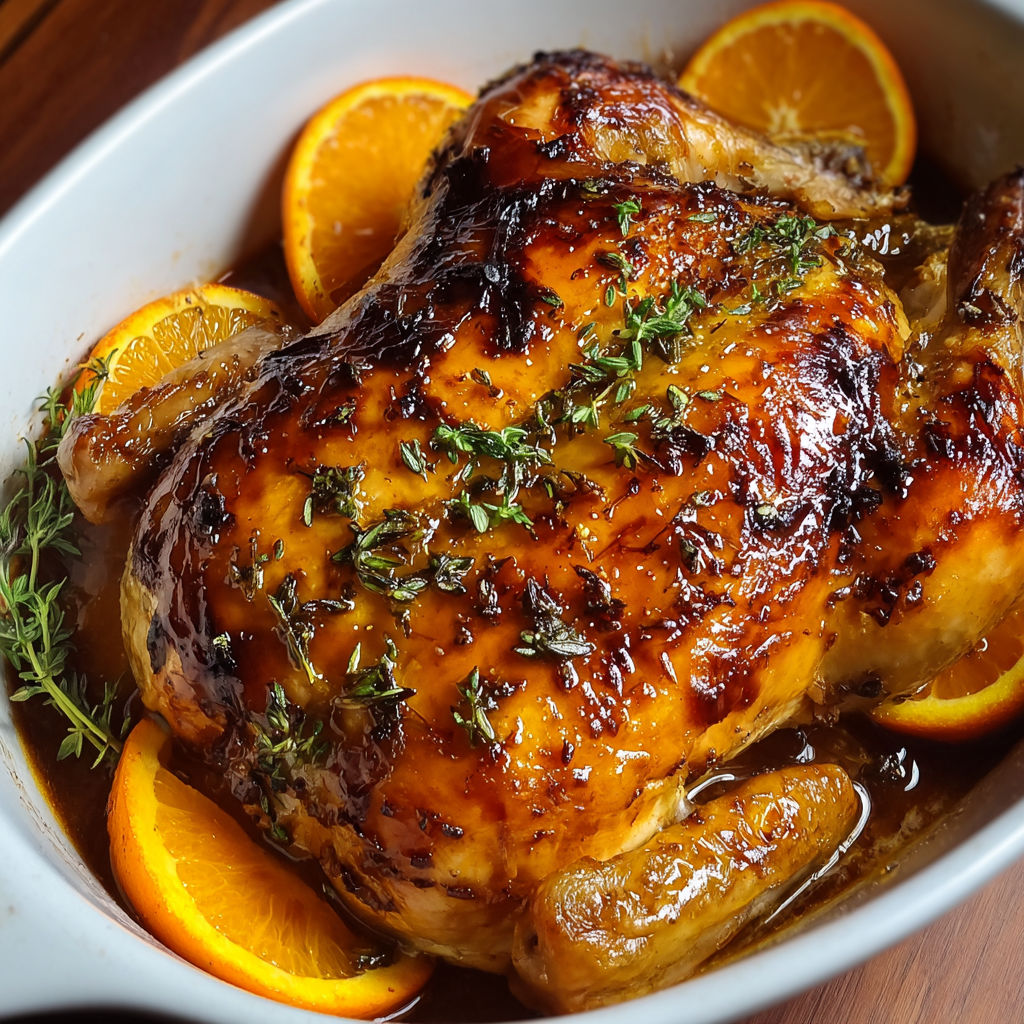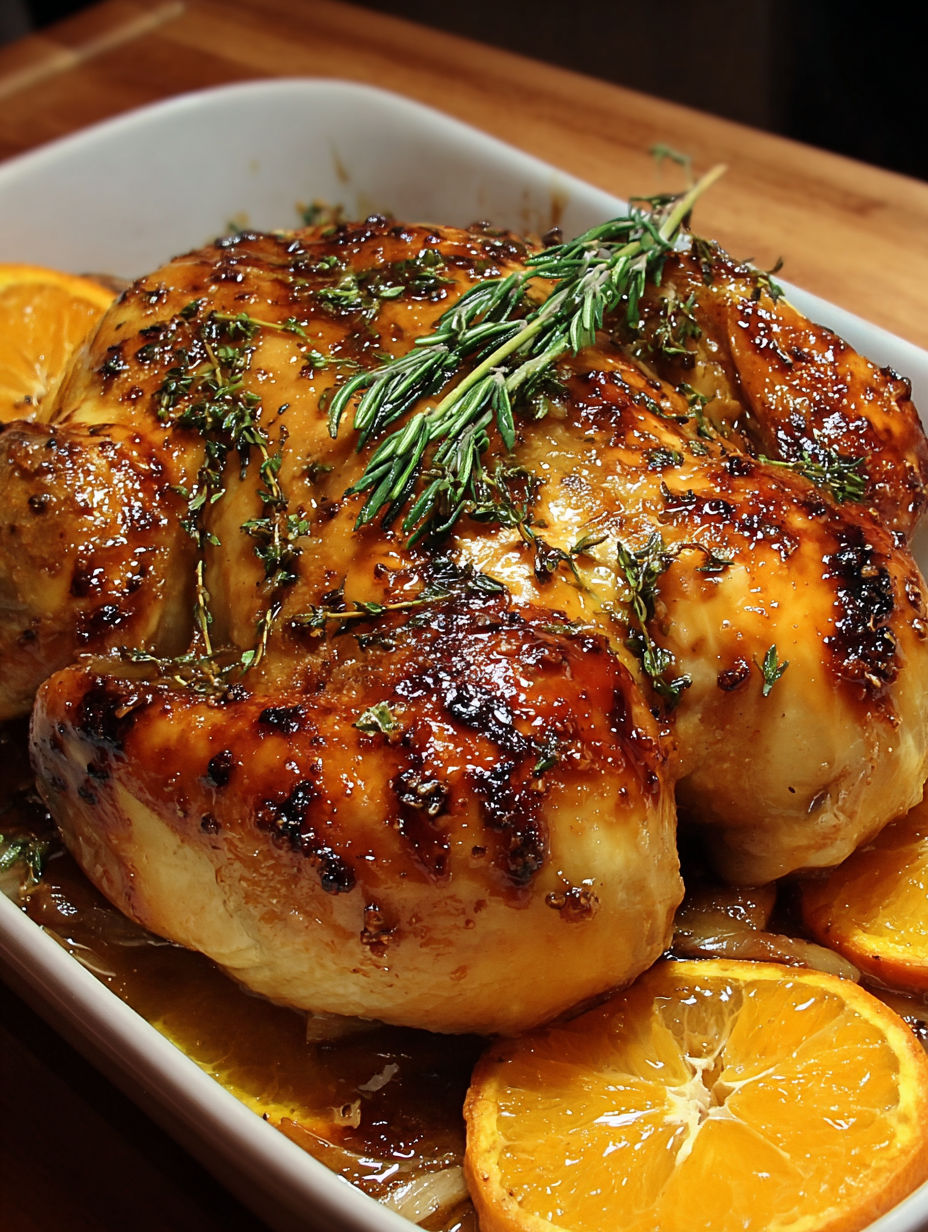 Pin
Pin
This succulent roasted orange chicken transforms an ordinary dinner into a memorable feast with its perfect balance of citrus, herbs, and savory flavors. The orange-infused glaze caramelizes beautifully on the skin, creating a stunning centerpiece for any meal while filling your kitchen with an irresistible aroma.
I first made this orange chicken when hosting my in-laws for the holidays, and it has since become our signature special occasion dish. Even my father-in-law, who rarely comments on food, asked for the recipe.
- Whole chicken 4–5 pounds look for one with intact skin and no discoloration
- Olive oil creates the base for the herb rub and helps crisp the skin
- Fresh garlic adds essential savory depth always choose firm cloves
- Fresh thyme and rosemary provide aromatic backbone fresh herbs make a noticeable difference
- Orange zest and juice the star ingredients that create the signature flavor
- Honey adds sweetness and helps the glaze caramelize beautifully
- Soy sauce contributes umami depth and balances the citrus
- Dijon mustard adds subtle tanginess and helps emulsify the glaze
- Onion infuses the chicken from within during roasting
- Chicken broth creates steam and prevents drying
- Butter enriches the final sauce for luxurious texture
How To Make Roasted Orange Chicken
- Prepare the chicken:
- Preheat your oven to 400°F and thoroughly pat the chicken dry with paper towels. This crucial step ensures crispy skin rather than steamed skin. Take your time removing all moisture.
- Season generously:
- Combine olive oil with minced garlic, chopped herbs, and seasoning, then massage this mixture all over the chicken. Work it under the skin where possible for maximum flavor penetration. The aromatic oils release during cooking and permeate the meat.
- Create the glaze:
- Whisk together orange zest, juice, honey, soy sauce, and Dijon until completely smooth. The zest contains essential oils that provide intense orange flavor, while the juice adds sweetness and acidity. The mustard helps emulsify everything into a cohesive glaze.
- Prepare for roasting:
- Stuff the chicken cavity with quartered onion pieces. They will steam from within, flavoring the meat and keeping it moist. Place the chicken breast-side up on a roasting pan and pour broth around but not over the chicken.
- Glaze and roast:
- Brush half the glaze over the entire surface of the chicken. Reserve the remainder for basting. Roast for approximately one hour, basting halfway through. The sugars in the honey and orange will caramelize, creating that signature golden-brown finish.
- Rest before serving:
- Allow the chicken to rest for at least 10 minutes after removing from the oven. During this time, the internal temperature will continue rising slightly, and more importantly, the juices redistribute throughout the meat rather than running out when carved.
The fragrance of this chicken roasting is truly one of my favorite kitchen moments. My daughter now associates this orange-herb aroma with special family gatherings. I particularly love the way the soy sauce adds depth without making the dish taste Asian—it simply enhances the natural flavors.

Perfect Pairings
This roasted orange chicken creates a beautiful partnership with roasted root vegetables. The vegetables can cook alongside the chicken, absorbing some of the flavorful drippings. I particularly recommend parsnips, carrots, and potatoes tossed with a bit of olive oil and herbs. A simple green salad with a light vinaigrette balances the richness of the chicken and completes the meal.
Make Ahead Options
You can prepare this chicken up to a day ahead by making the herb rub and orange glaze, then storing them separately in the refrigerator. You can even season the chicken and keep it uncovered in the refrigerator overnight—this actually helps dry the skin for extra crispiness. Just bring everything to room temperature about 30 minutes before roasting.
Using Leftovers
Leftover orange chicken makes incredible sandwiches or wraps. Shred the meat and toss with a bit of mayonnaise, fresh herbs, and a squeeze of orange juice. Alternatively, add it to a grain bowl with quinoa or farro, roasted vegetables, and a simple vinaigrette. The flavors often deepen by the next day, making leftovers something to look forward to.
The Secret to Perfect Skin
The key to achieving that picture perfect crispy skin lies in thoroughly drying the chicken before seasoning and roasting at the proper temperature. Starting with a completely dry bird allows the skin to crisp rather than steam. Also, avoid the temptation to frequently open the oven door during roasting, as this lowers the temperature and extends cooking time.

Recipe FAQs
- → What's the best way to ensure the chicken skin gets crispy?
Pat the chicken completely dry with paper towels before seasoning, as moisture prevents crisping. Also, make sure to thoroughly coat the skin with olive oil, and roast at the recommended 400°F temperature which helps render the fat and crisp the skin.
- → Can I make this with chicken pieces instead of a whole chicken?
Yes! You can use chicken thighs, breasts, or a mix of pieces. Adjust the cooking time accordingly - bone-in pieces typically need 35-45 minutes, while boneless pieces may only need 25-30 minutes. Continue to baste with the orange glaze for the same delicious flavor.
- → What side dishes pair well with this orange chicken?
This chicken pairs beautifully with roasted potatoes, wild rice, or couscous to soak up the flavorful sauce. For vegetables, consider roasted Brussels sprouts, steamed green beans, or a light arugula salad with a citrus vinaigrette to complement the orange flavors.
- → Can I prepare the orange glaze in advance?
Absolutely! The orange glaze can be prepared up to 3 days ahead and stored in an airtight container in the refrigerator. Bring it to room temperature before using, as cold glaze won't spread as easily on the chicken.
- → How do I know when the chicken is fully cooked?
The most reliable method is using a meat thermometer inserted into the thickest part of the thigh (without touching bone), which should read 165°F (75°C). If you don't have a thermometer, ensure the juices run clear when you pierce the thigh, and the leg moves easily in its socket.
- → Can I use dried herbs instead of fresh ones?
Yes, though the flavor won't be quite as vibrant. Use one-third the amount called for fresh herbs - so 1 teaspoon dried thyme instead of 1 tablespoon fresh, and the same for rosemary. Rub the dried herbs between your palms before adding to release their essential oils.
